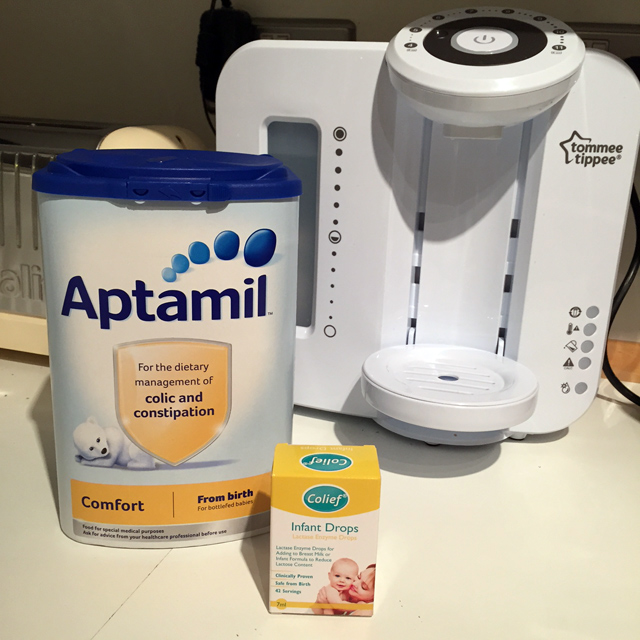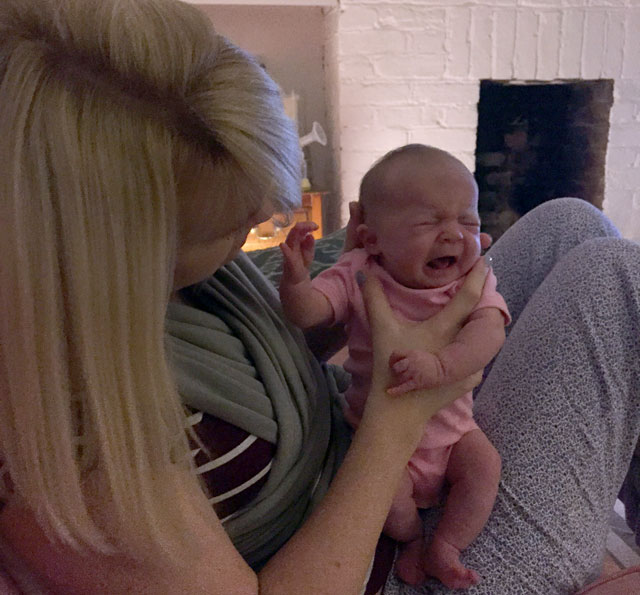The Colic Diaries: Colief and Comfort milk

In my last post about colic, I talked about how we found using Infacol and Gripe Water. Once we realised these weren't really touching the sides, we moved onto the big guns. First up, Colief.
Colief is a lactase enzyme that you put into baby's milk (it works with breast milk and formula) to reduce the level of lactose in the milk. It works on the belief that colic is caused by a baby's inability to digest lactose when they are tiny - until they are about three months old and their gut 'matures'. (Nice). Up until then, they get bloating and IBS like symptoms thanks to not being able to digest lactose, and it's this pain that makes them cry. Now, I don't quite now how Colief works for breastfeeding mums, but for us, we simply warmed Daphne's milk and put in four drops of this stuff half an hour before she needed to be fed. The warmth and the half an hour are required in order for the enzyme to do its job. Suffice to say, it was a bit of a faff.
We started using Colief when she was about six weeks old, I think. And we did see a big improvement in her wind - she definitely farted less and was much less 'burpy' after we started using it. We were quite pleased - it seemed to be helping and although she was still crying a lot at night, it was clear she was in much less pain than before.
However, Colief has one big downside - it costs a bloody fortune. It's about £12 for a tiny bottle that lasted just over a week. We asked the GP if she would prescribe it for Daphne, but she refused. I think you can get it on prescription but it depends where you live whether your Primary Care Trust reckons it's a medicine or not.
The other problem with Colief is sometimes we didn't have half an hour's warning before Daph wanted to be fed - and so it was all a bit hit and miss with whether the enzyme actually had time to work. After the occasional bottle left her crying and windy like before, we decided it would be easier and more consistent to move onto Comfort milk.
Comfort milk ostensibly does the same as Colief - it's already had much of the lactose removed, and it's also slightly thicker so it makes it harder for babies to gulp it, which means less wind. It says on the packet that it should only be used under medical advice, but I'm not sure anyone takes much notice of that.
I'd been putting off using Comfort milk, as I said before, because it only comes as a powder, not in ready-made bottles. So we had to start the whole palaver of sterilising the bottles and the powder and making it up with boiling water and leaving it to cool. Hence the acquisition of the wondrous Tommee Tippee Perfect Prep machine - which has done away with all this aggro and made it super easy to use.
The first time we gave Daphne Comfort milk, it was like some kind of magic drug - she fell asleep while drinking it, completely content and with no farting or burping or wriggling about. Sadly, this magic effect wore off after a couple of days, as she got used to the milk, but there's been a 100% improvement in her digestion since we put her on it. In that sense, it's been a bit of a miracle cure for us.
There are some downsides however. It makes Daphne's poo avocado green, which is somewhat alarming, but more upsettingly, her poos now absolutely STINK. To the point that when we change a nappy, we pretty much have to fumigate the room afterwards. But it's a small price to pay for a happier baby.
They say that when a baby reaches 3-4 months, their guts should have matured enough to be able to process lactose more easily, but I'm reluctant to change Daphne's milk again, so we're keeping her on the Comfort milk at least until she's weaned.
Next week, in my final thrilling post about colic, I'll talk about our experience with cranial osteopathy! Something to look forward to folks. The excitement! ;)
Read Part One of The Colic Diaries >
Read Part Three of The Colic Dairies >
THE RIVAL, my novel about career and motherhood, is on sale now. You can find out more about THE RIVAL here, and order here if you want to make my day. UNFOLLOW ME will be published in June.
The Colic Diaries: Infacol and Gripe Water
Hello there! I'm afraid this post will probably only be interesting to you if you have a baby with colic, or if you are about to have a baby and are concerned he/she may get colic. If not, you're probably better off skipping it as it'll be a bit of a snorefest. You have been warned!
However, if your baby has colic, then please let me send you a massive great big bear hug across the internet, and tell you that it's going to be OK. It really is. I promise. And don't worry if you sometimes feel like you want to throw your baby out of a window. Or get in the car and drive a very very long way away from the NEVER ENDING NOISE. It's normal. And you won't (throw the baby out the window, or run away).
I had no idea what colic was until about three days after Daph was born, when I finally had time to rummage through the Bounty pack they give you when you leave hospital. In it was a leaflet all about Infacol, explaining what colic was. I remember reading it and thinking it didn't sound too bad, and that it was good to know there was a 'medicine' that could take care of it. Ha!
Anyway for the first three weeks of her life Daph was pretty much a dream baby - she slept easily and often and although her waking times were unpredictable, she definitely slept well in the evenings, and we actually watched a bit of TV. Then at around three weeks, she started to get grumpy in the evenings. We noticed she was farting a lot, and always had a really tight tummy, but winding her was hard because she was so tiny. After a few days, the grumpiness turned into full-on crying sessions, with the typical arched back and legs they warn you about. It was then that I realised we were one of those 'lucky' one in five parents who have babies with colic.
No one seems to know exactly what colic is, or what causes it. Which seems ridiculous when you think they've been sending men into space since the 1960s. But anyway. Some people think it's related to digestive issues, whereas others say it's more about the baby's brain development - there's even a newish thing called 'the period of purple crying' which is now being touted about to reassure parents (and to stop them throwing their babies out of windows). I have my own theories - but for us, Daph's colic was definitely related to her digestion.
Colic is hideous. Forget waterboarding, stick a prisoner in a room with the soundtrack of a colicky baby's cry and they'd give up their secrets in seconds. Daphne would cry and cry for around three hours every night, every day, starting at about 8pm, without fail. She would cry as though she was in pain, but would have momentary pauses where she'd suddenly be all happy again, before the crying restarted. Nothing we did could stop her crying. Feeding her, bathing her, massaging her, singing to her, bouncing her, rocking her, cuddling her. None of it made any difference. When she was crying she would also fart a lot - as though the farting hurt her. It was pretty horrific - probably the hardest thing I've ever had to cope with.


Anyway, we tried so many things to help her, so I thought I'd do a series of posts about what we tried and what worked. First up: Infacol. This orange-flavoured syrupy substance apparently helps babies bring up wind by binding together all the trapped bubbles of air in their stomachs and making them easier to burp up in one go. It was the first thing we tried, and we used it religiously before every feed for two months. Did it help? I don't know. We spoke to our GP about it and she said that its real value is in calming the parents down as they believe they are doing something to help. She seemed very dismissive of it. We stopped using it after about eight weeks and I can't say that it made any difference when we gave it up. But by then, she was bigger and found burping easier. Daphne definitely liked it/the taste - and it always helped calm her down when we pipetted it into her mouth. So in that sense, I guess it had a soothing effect and was of some benefit.


As for Gripe Water - people have sworn by this for years. We only tried it a few times, mostly after she'd eaten and was screaming with wind, and again, it had the magical effect of distracting her for a few minutes. But otherwise, I think it did less than Infacol. It's also a pain in the arse to administer as it doesn't come with any kind of dropper device so you have to try to give it to the baby on a spoon, but it's ridiculously sticky and goes everywhere. In the good old days when we were kids it had alcohol in it, and so it basically got your baby so drunk she feel asleep. Not sure why they had to take the alcohol out but probably something to do with the WHO or the EU spoiling everyone's fun. Only kidding. Anyway I actually have half a bottle of it left so that shows you how little use it was for us.
If you have a baby with colic, I think both Gripe Water and Infacol are worth a try, but I do think what's more important is trying to work out why your baby is crying. If it's this 'period of purple crying' thing, then these are unlikely to have any effect, and really, you just have to ride it out (although I will say that not enough is said about overstimulating babies - why don't they warn you that tiny babies' brains can hardly cope with anything?!). However if it's a more obvious digestion issue, then they may help. But what helped us more with that was Colief, of which I'll write more in the next post...
Read Part Two of The Colic Diaries >
Read Part Three of The Colic Dairies >
THE RIVAL, my novel about career and motherhood, is on sale now. You can find out more about THE RIVAL here, and order here if you want to make my day. UNFOLLOW ME will be published in June.


